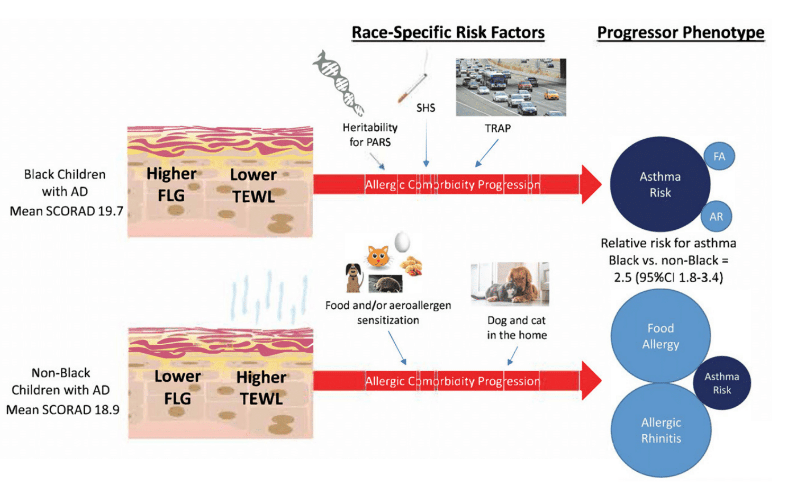‘Atopic March’ Can Vary Along Racial Lines
Published May 2022 | Journal of Allergy and Clinical Immunology
When it comes to the ‘atopic march,’ a classic pattern of skin damage earlier in life leading to severe allergies and asthma later in life, Black and White children often follow the beats of different drummers.
In one the few studies to carefully examine how ethnicity can influence asthma risk, a research team led by Jocelyn Biagini, PhD, and Gurjit K. Khurana Hershey, MD, PhD, found clear differences between the experiences of Black and White children who were among 600 participants in the Mechanisms of Progression of Atopic Dermatitis to Asthma in Children (MPAACH) cohort.
White children were more likely to be sensitized to aero and food allergens and more than three times more likely to develop food allergy and/or allergic rhinitis without asthma risk. In contrast, Black children were over six times more likely to proceed to high asthma risk, without developing food allergies or allergic rhinitis.
Black and White children with AD have distinct allergic trajectories defined by different longitudinal endotypes,” Biagini says. “These observed racial differences are likely due in part to increased genetic heritability for asthma risk and more-frequent harmful environmental exposures affecting Black children.”
While White children appear to be heavily affected by exposures to pet allergens and reactions to foods, Black children are more likely to live in areas with higher levels of particulate air pollution and around more people who smoke.
Until now, nearly all data about childhood asthma risk has been based on studies of White children. Finding racial disparities in risk factors will help improve decision-support tools that many clinicians use to decide when intervention is needed.
“Collectively, our findings provide a new paradigm for an atopic march that is inclusive of Black children,” Biagini says.
Atopic March Progression in Children Participating in the Mechanisms of Progression of Atopic Dermatitis to Asthma in Children (MPAACH)
Longitudinal Cohort (n=601) Differs by Race
AD: atopic dermatitis, AR: allergic rhinitis, FA: food allergy, FLG: filaggrin, PARS: Pediatric Asthma Risk Score,
SCORAD: scoring for atopic dermatitis, SHS: secondhand smoke, TEWL: trans-epidermal water loss,
TRAP: traffic-related air pollution






